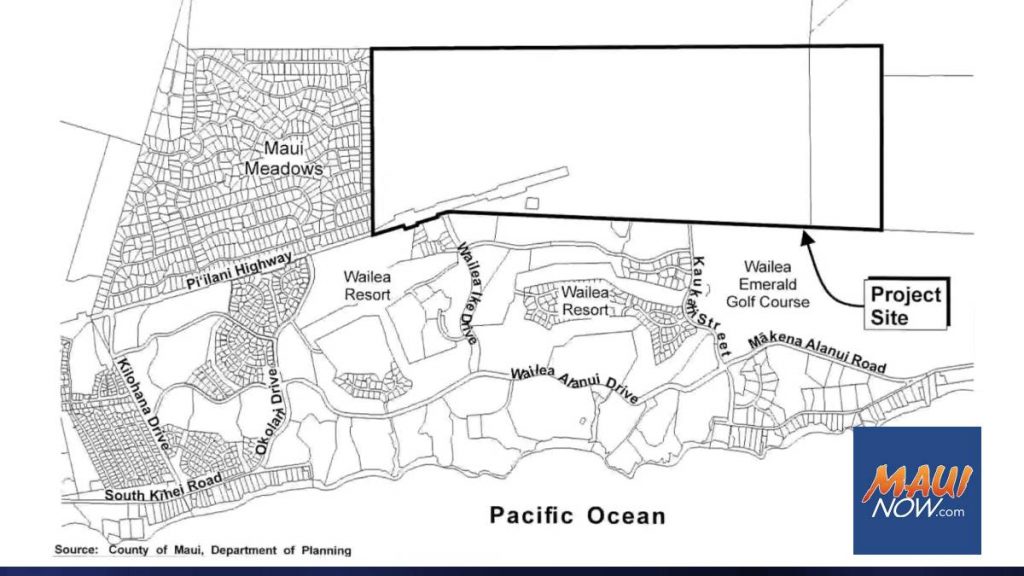Major 670-acre housing project at Honuaʻula aims to move ahead; groups intervene

A long-debated master planned community proposed for 670 acres in South Maui called Honuaʻula sought the next phase of county approval today — but two groups are challenging it.
Honuaʻula would develop single- and multi-family homes, village mixed uses, preservation, conservation and recreational/open space areas, along with infrastructure. Of the 861 homes proposed, another 288 units would be workforce housing. Also, 25% of the total project area will be dedicated to permanent preservation via conservation easement. The project is located on about 670 acres adjacent to Maui Meadows and Wailea Resort in South Maui.
With no opposition from Honua’ula attorney, Cal Chipchase, Maui Planning Commission voted unanimously Tuesday to approve the intervention of two community organizations, Maui Tomorrow Foundation and Hoʻoponopono O Mākena, represented by attorney Ryan Hurley. Intervenors can participate in a contested case as a party, and they have the rights and responsibilities that the role entails, such as presenting evidence and cross-examining witnesses.
“We looked at the issues that were raised, and we think that they aren’t complicated,” Chipchase said before the vote. “We won’t fight the procedural step; we will welcome them to the table. We are very open with this project. We’ve got good answers to all of the questions and we look forward to bringing the answers before you.”
The groups sought intervention, saying in a letter that they have property interests in property near the project area; they will be directly and immediately affected by the requested action; and they have substantial interests in the proceedings, among other reasons.
Also, Maui Tomorrow in a group email said the project doesn’t have enough affordable homes and said plans will have negative environmental and cultural impacts.
“We have some serious concerns with the project,” Hurley said. “That’s the most important thing is that the petitioners, the intervenors, have due process in this procedure. I think rushing it is a mistake. I think the commission hearing it is dangerous. I think some errors could be committed. If that’s the way you folks want to go, we’re not going to oppose that.”
Mediation steps will begin after the commission meeting today. If no agreement can be found by the commission’s next meeting March 8, a contested case hearing will start with March 22, with the commission appointed as hearing officer.
If parties reach an agreement, then the commission will move forward to consider the project’s request for District Phase II Development Approval. The project still needs multiple approvals and permits before breaking ground.
Meanwhile, testimony on the project was mixed Tuesday.
Supporters called it a balance of preservation and housing; opponents called the workforce units negligible and said the project will have negative environmental and cultural impacts.
Todd Apo of Hawaii Community Foundation said he’s glad the project has a chance to move forward.
“I think it not only brings about the housing that’s needed for Maui but . . . these improvements around preservation and infrastructure for drainage sounds like it’s much needed in the area,” he testified.
Justin Kekiwi, a lineal descendant of the area, said the project is not in the best interest of the community.
“It’s not for our community — let’s be real,” he said. “Going through the proper steps to do the right thing and actually doing the right thing is different.”
Maui County Council in the 1990s approved the project’s district zoning. Then, in 2008, it granted the project’s District Phase I Development Approval, which came with many conditions. The approvals were challenged, resulting in the need for a new environmental impact statement and environmental assessment.
In 2012, Maui Planning Commission accepted the EIS and EA. The same year, Sierra Club and Maui Unite challenged the EIS.
A 2016 settlement agreement established north and south preserve areas and an agreement with the county on form and terms of conservation easement to be overseen by a land trust. It also provides interim and long-term access protocols for the public; ensures protection of historic trails; and expands the Maui Meadows buffer.
According to a project overview, the environmental impact statement was completed and accepted; archeological reports were accepted by the State Historic Preservation and Office of Hawaiian Affairs.
The project would include 515 single-family residential units, 346 multifamily residential units and 288 workforce housing units, along with 24 acres of village mixed use and 103 acres of recreation and open space.












